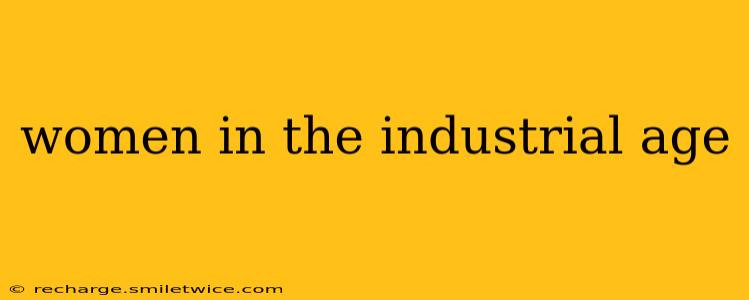The Industrial Age, spanning roughly from the late 18th to the mid-20th century, witnessed a seismic shift in societal structures, profoundly impacting the lives of women. While often overlooked in historical narratives focused on technological advancements and male industrialists, women's experiences during this period were pivotal, characterized by both unprecedented opportunities and persistent inequalities. This exploration delves into the multifaceted roles women played, the challenges they faced, and their enduring legacy.
What were the main changes for women during the Industrial Revolution?
The Industrial Revolution drastically altered the landscape of women's lives. The shift from agrarian to industrial economies created new employment opportunities, primarily in factories and textile mills. While many women continued their traditional roles in domestic service and agricultural labor, a significant portion entered the burgeoning factory system, often working long hours under harsh conditions for low wages. This influx into the workforce, however, didn't automatically equate to empowerment. It frequently meant facing exploitation and limited social mobility. Simultaneously, the rise of urbanization led to changes in family structures and social expectations, although these changes rarely benefited women equally.
How did industrialization impact women's work?
Industrialization significantly impacted the nature of women's work. Pre-industrial women often engaged in diverse tasks within the home and community, contributing to family subsistence through activities like spinning, weaving, and food production. The factory system, while offering new employment avenues, often involved repetitive, monotonous tasks in crowded, unsafe environments. Many women found themselves working in textile mills, coal mines, and other industries, subjected to long hours, low pay, and dangerous working conditions. The concentration of women in specific industries – such as textile manufacturing – contributed to the gendered division of labor that persisted for generations.
What were the working conditions for women in factories during the Industrial Revolution?
Working conditions for women in factories during the Industrial Revolution were notoriously harsh. Factories often lacked proper ventilation, lighting, and sanitation, posing significant health risks. Long working hours, sometimes exceeding 12 hours a day, were the norm, with little to no breaks. Machinery was often poorly maintained, resulting in frequent accidents and injuries. Wages were significantly lower for women than for men, perpetuating economic inequality. Child labor was also rampant, with many women working alongside their children in factories. These conditions contributed to widespread poverty and poor health among women in the industrial workforce.
Did women's roles in society change during the Industrial Revolution?
While the Industrial Revolution didn't fundamentally alter all aspects of women's roles overnight, it initiated a slow but significant transformation. The increased participation of women in the workforce challenged traditional gender roles, even if subtly. Women's contribution to the industrial economy became increasingly visible, although their economic independence remained limited by pervasive pay gaps and social biases. The rise of urbanization also led to changes in family structures, with families becoming smaller and more nuclear. However, the burden of domestic labor remained largely on women, even as they juggled factory work.
What impact did the Industrial Revolution have on women's lives overall?
The Industrial Revolution had a complex and multifaceted impact on women's lives. It introduced both opportunities and challenges. While it offered new avenues for employment and economic participation, it simultaneously subjected women to harsh working conditions, low pay, and continued societal inequality. The long-term consequences of this period shaped women's roles in society for decades to come, laying the groundwork for future movements advocating for women's rights and equal opportunities. The Industrial Revolution's legacy reminds us of the enduring struggle for gender equality, a struggle interwoven with the very fabric of industrial development. It also highlights the importance of acknowledging the contributions and experiences of women, whose stories are often marginalized within larger historical narratives.
